Vulnerable Populations: Implications for Mentally Ill
Robin Cooper, MD
Although climate disruption is already affecting all of us in some way now and will continue to worsen as climate effects increase, the effects are not uniform. The most vulnerable tend to be the youngest and oldest and those already sick, including the mentally ill. anAdditionally, Poor people are and will continue to bear the brunt of climate change impacts. (1)
VULNERABLE POPULATIONS (2,3)
Vulnerable populations for the impacts of climate change include:
Children
the elderly, especially the frail
medically ill and disabled , including mentally ill
women especially pregnant, post-partum women and those caring for small children
occupations that require more exposure to weather extremes (i.e.farm worker, construction workers)
indigenous populations living close to natural environment
first-responders exposed to the traumas of major weather disasters
Low-income groups who live in poorer communities homeless population
Mentally Ill
The mentally ill and substance abusers are particularly vulnerable to the impacts of climate change. They disproportionately have higher rates of all of the negative social factors that compound their risks of more serious consequences.
Additionally, the mentally ill have unique factors attributable to the underlying psychological difficulties including but not limited to:
Cognitive impairments and executive function difficulties which can interfere with assessment of risk and awareness of health threats, impaired ability to consistently plan and execute protective action
Fragile coping mechanisms challenged during stress which can lead to impaired judgment and poor behavioral responses including greater use of alcohol, drugs, violence
Greater social isolation,
Dependence on social service and mental health system which may be interrupted during severe weather events;
Greater vulnerability to heat related effects
Reliance on medications that can have adverse impacts on heat regulation and fluid homeostatic Homeless mentally ill: The mentally ill disportionately make up the legions of homeless people. Rates of mentally ill in the homeless populations are in the range of 25% far exceeding rates in general population that are closer to 6%. Substance abuse is rampant in this population. The homeless have little ability to protect themselves from extreme weather exposures. (4, 5)
References
Compton, M, Shim, R. Social Determinants of Mental Health, APA Publishing , 2015
US Global Change Research Program, Impacts of Climate change on Human Health in the United States. Chapter 8 & 9, (2016)
Weir, E, 2002 heat wave: First, Protect the vulnerable, Canadian Medical Association Journal, 167, 169
SAMHSA, 2011: Current Statistics on Prevalence and Characteristics of People Experience Homelessness in the United States, 23pp. Substance Abuse and Mental Services Administration:. https://www.samhsa.gov/homelessness-programs-resources
North, C. et al, 2004, Are Rates of psychiatric illness in the Homeless population changing?
Am Public Health Journal, January 2004


